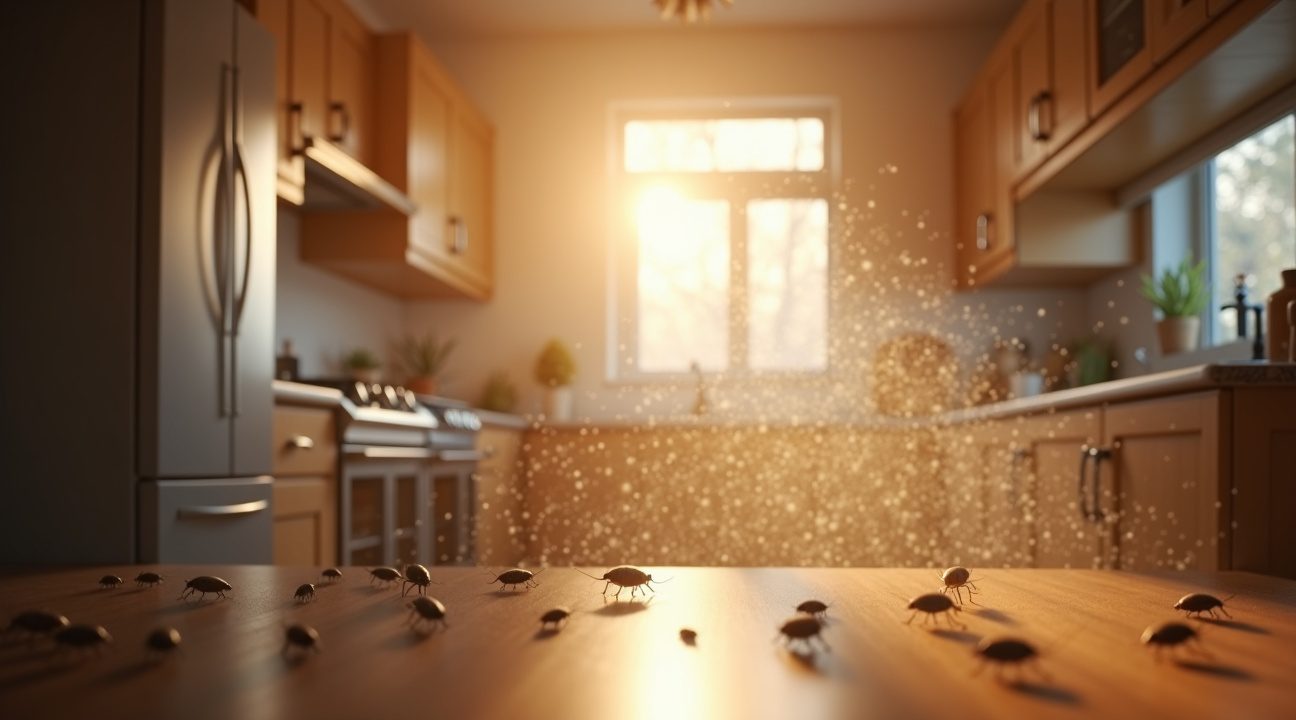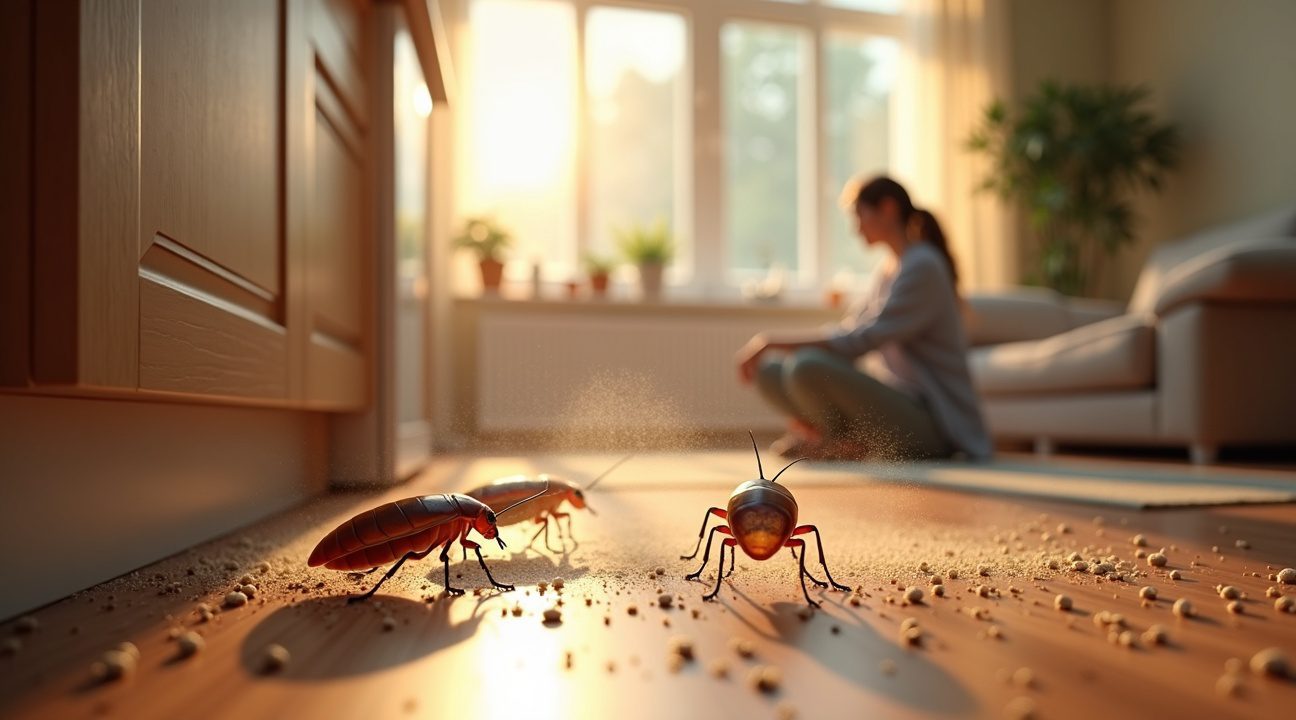Cockroaches silently contaminate indoor air with potent allergens and bacterial toxins that can trigger severe asthma attacks and respiratory problems.
Research conducted by North Carolina State University has established a direct link between cockroach infestations and significantly elevated pollutant levels in the dust and air of indoor environments. These invasive pests infiltrate kitchens and other domestic areas, where their droppings, saliva, and shed skins break down into microscopic particles. These particles become airborne through routine household activities and can circulate for hours, exposing occupants to serious health hazards.
Key Takeaways
- Cockroach allergens originate from droppings, saliva, and shed skins that become fine airborne particles easily stirred up during cleaning, walking, or cooking.
- Female cockroaches emit nearly twice the toxins of males due to heightened feeding during egg-carrying periods, contributing an average of 1.2% to indoor air microbiomes and 4.0% to household floor dust.
- Kitchen areas are at highest risk due to cockroaches’ preference for food, moisture, and warmth found near appliances and preparation areas.
- Total cockroach eradication significantly improves air quality more than partial elimination, as even a few remaining cockroaches keep producing allergens and perpetuating contamination.
- Persistent allergens and toxins remain in the environment long after pests are removed, requiring thorough cleanup with HEPA filtration, deep cleaning agents, and maintenance of HVAC systems for full air quality restoration.
Your Kitchen Could Be a Hidden Source of Asthma-Triggering Toxins
I’ve discovered that cockroaches represent one of the most dangerous yet underestimated threats to indoor air quality in homes across America. Most homeowners don’t realize these persistent pests are silently contaminating their living spaces with potent allergens and bacterial toxins that can trigger severe asthma attacks and respiratory problems.
Research from North Carolina State University has established a direct connection between cockroach infestations and dramatically elevated levels of allergens and endotoxins in household dust and air. This groundbreaking study reveals just how significantly these unwanted visitors compromise indoor air quality, creating invisible health hazards that affect families daily.
Food Preparation Areas Face the Greatest Risk
The kitchen stands as ground zero for cockroach-related air contamination. Homes with active cockroach infestations consistently show much higher levels of these harmful pollutants, with the most dangerous concentrations appearing in food preparation areas. This makes perfect sense when I consider that cockroaches are naturally drawn to kitchens for food sources, moisture, and warm hiding spots.
The proximity to cooking and eating spaces makes this contamination particularly concerning. Every meal preparation session can potentially stir up settled allergens, sending them back into the air where family members breathe them in. Counter surfaces, cabinet interiors, and areas around appliances become reservoirs for these microscopic toxins.
The Science Behind Airborne Contamination
Cockroach-derived allergens originate from three primary sources that create ongoing contamination cycles:
- Droppings that break down into fine particulate matter over time
- Saliva deposits left behind during feeding activities
- Shed skins that naturally flake off as cockroaches molt and grow
All of these materials disintegrate into extremely fine particles that easily become airborne, especially in busy kitchen environments. Normal household activities like cooking, cleaning, or simply walking through the space can launch these particles into the air circulation system. Once airborne, these allergens can remain suspended for hours, traveling throughout the home via HVAC systems and natural air currents.
The endotoxins produced by bacteria living on cockroaches add another layer of danger to this contamination. These bacterial toxins can trigger inflammatory responses in the respiratory system, making existing asthma conditions worse and potentially causing new sensitivities to develop in previously healthy individuals.
Understanding this contamination process helps explain why some families experience persistent respiratory issues despite maintaining clean homes. The microscopic nature of these allergens means they’re virtually invisible to the naked eye, yet they pack a powerful punch when it comes to triggering asthma and allergic reactions.
Professional pest control becomes essential not just for eliminating visible cockroaches, but for breaking this cycle of ongoing air contamination. Even after successful elimination, thorough cleaning of affected areas remains crucial to remove accumulated allergens that could continue causing problems for months afterward.
I recommend paying special attention to hidden areas where cockroaches typically hide and deposit these contaminating materials. Behind appliances, inside cabinet crevices, and around plumbing fixtures often harbor the highest concentrations of these dangerous allergens. Regular deep cleaning of these spaces, combined with proper pest prevention measures, provides the best defense against

How These Invisible Invaders Actually Poison Your Air
Cockroaches poison indoor air through a systematic process that begins with their feeding habits. I’ve observed how these pests consume virtually any organic material they encounter, from food scraps to dead skin cells. During this consumption process, their digestive systems harbor dangerous bacteria that multiply rapidly in the warm, moist environment of their bodies.
The Hidden Mechanism of Airborne Contamination
The real danger emerges when these bacteria die inside the cockroaches’ digestive tracts. Bacterial endotoxins release from the dead microorganisms and concentrate in cockroach waste products. Every time these insects defecate, they’re essentially depositing toxic particles throughout your living space. These microscopic contaminants don’t simply disappear—they accumulate in household dust and eventually become airborne through normal daily activities like walking, vacuuming, or even air circulation from heating and cooling systems.
Female cockroaches pose a significantly greater threat than their male counterparts. Research shows that females produce almost twice as many toxins due to their increased food consumption during egg-carrying periods. This heightened feeding behavior means more bacterial ingestion, more endotoxin production, and ultimately more contamination in your home’s air supply.
The numbers reveal just how substantial this contamination can be:
- Cockroach bacteria contribute an average of 1.2% to indoor air microbiomes.
- 4.0% of floor dust composition is attributed to cockroach-related bacteria.
While these percentages might seem small, they represent enough bacterial presence to meaningfully impact air quality and create serious microbiological health risks for anyone breathing that air regularly.
I can’t stress enough how insidious this process is because it’s completely invisible to homeowners. You won’t see these airborne allergens floating around your living room, but they’re there, accumulating with each passing day that cockroaches remain in your home. The particles are so small they easily bypass basic air filtration systems and penetrate deep into lung tissue when inhaled.
Every surface these insects touch becomes a potential launch pad for more contamination. When cockroaches crawl across countertops, inside cabinets, or along baseboards, they leave behind trace amounts of their contaminated waste. These deposits dry out and eventually break apart into even smaller particles that join the household dust circulation. Indoor air quality concerns have become increasingly important for health-conscious homeowners who understand the connection between environmental toxins and respiratory health.
The continuous cycle of ingestion, contamination, and airborne particle distribution means that even a small cockroach population can generate significant indoor air pollution over time. This invisible threat operates 24 hours a day, constantly adding new contaminants to your home’s atmosphere while you sleep, work, and live in the space.

The Alarming Connection Between Roaches and Respiratory Disease
Cockroach allergens stand as one of the most significant triggers of asthma attacks in urban environments, creating an invisible threat that countless families unknowingly battle daily. I’ve seen how these microscopic proteins, released through cockroach droppings, shed skin, and body parts, can transform a seemingly safe home into a respiratory minefield for vulnerable individuals.
Children and adults with pre-existing respiratory conditions face the greatest danger from cockroach-derived allergens. These proteins don’t simply cause mild discomfort – they actively trigger severe allergic reactions that manifest as asthma attacks, chronic bronchial irritation, and persistent allergic rhinitis. The impact becomes particularly devastating for young children whose developing respiratory systems can’t effectively filter out these harmful particles.
Homes with poor ventilation systems or overcrowded living conditions create perfect conditions for allergen accumulation. Airborne particles from cockroach waste and debris linger in stagnant air for extended periods, continuously exposing residents to these respiratory irritants. I’ve observed that densely populated apartments and houses with limited air circulation often harbor the highest concentrations of these dangerous allergens.
High-Risk Environments and Vulnerable Populations
Several factors increase exposure risk and symptom severity for household members:
- Multi-family housing units with shared ventilation systems that spread allergens between units
- Basement apartments and ground-floor dwellings where moisture attracts larger cockroach populations
- Homes near restaurants, garbage disposal areas, or food processing facilities
- Living spaces with carpeting and upholstered furniture that trap allergen particles
- Households with elderly residents or immunocompromised individuals
Endotoxin exposure compounds the respiratory threat significantly. These bacterial toxins, present in cockroach waste, worsen symptoms in people already sensitized to cockroach allergens and create additional barriers to effective asthma control. Endotoxins can trigger inflammatory responses that persist long after initial exposure, making recovery more difficult and potentially leading to chronic respiratory complications.
Urban areas show consistently higher rates of cockroach-related asthma, particularly in communities with limited access to pest control resources. The combination of allergen exposure and endotoxin contamination creates a dual respiratory assault that standard air purifiers and cleaning methods often can’t adequately address.
Healthcare providers increasingly recognize cockroach allergens as primary asthma triggers, especially when traditional treatments fail to provide adequate symptom control. Patients experiencing frequent nighttime asthma attacks, persistent coughing, or unexplained respiratory symptoms may be reacting to cockroach allergens present throughout their living environment.
The relationship between cockroach allergens and respiratory disease extends beyond immediate asthma attacks. Chronic exposure can lead to increased bronchial sensitivity, making individuals more susceptible to other environmental triggers like pollen, dust mites, or chemical irritants. This heightened sensitivity often results in year-round respiratory symptoms that resist conventional treatment approaches.
Professional pest management becomes essential for breaking the cycle of allergen exposure and respiratory symptoms. Simply eliminating visible cockroaches doesn’t address the lingering allergen contamination that can persist in carpets, furniture, and ventilation systems for months after an infestation ends. Comprehensive cleaning protocols and ongoing monitoring help ensure that allergen levels drop to safer ranges for sensitive individuals.
Understanding this connection empowers homeowners to take proactive steps in protecting their family’s respiratory health. Regular monitoring for early signs of cockroach activity, combined with proper ventilation maintenance and professional pest control services, creates a more effective defense against these hidden respiratory threats than reactive approaches alone.
Why Getting Rid of Roaches Still Isn’t Enough
Eliminating live cockroaches doesn’t automatically solve the air quality problem they’ve created in your home. Cockroach allergens and endotoxins persist in the environment for months after the insects themselves are gone, continuing to contaminate indoor air unless you take comprehensive action.
The invisible threat lurks in dust particles, fabric fibers, and hidden crevices throughout your home. Even after successful extermination, these microscopic allergens remain active and dangerous. They continue circulating through your HVAC system, settling on surfaces, and triggering asthmatic reactions in sensitive individuals.
Complete Elimination vs. Partial Control
Full elimination of cockroaches produces dramatically different results compared to partial reduction efforts. Homeowners who achieve complete cockroach control experience sharp drops in both airborne allergens and endotoxin levels. Conversely, reducing the cockroach population by only 50–70% fails to create meaningful improvements in air quality.
The reasons for this stark difference include:
- Remaining cockroaches continue producing fresh allergens daily
- Partial infestations maintain breeding cycles that sustain contamination
- Incomplete removal leaves established allergen reservoirs untouched
- Live insects continue spreading existing allergens throughout the home
Professional pest control services understand this principle and implement strategies designed for complete elimination rather than simple reduction. They target not just visible cockroaches but also eggs, nymphs, and hidden populations that homeowners typically miss.
Research demonstrates the effectiveness of comprehensive approaches. Three months after professional treatment, homes receiving complete cockroach elimination showed drastic reductions in harmful biological pollutants. Six months post-treatment, these improvements remained stable and significant. Meanwhile, untreated homes or those receiving only partial treatment showed minimal improvement in air quality metrics.
The Importance of Environmental Cleanup
Environmental cleanup becomes crucial for achieving lasting results. Effective cleanup includes:
- Thorough vacuuming with HEPA filters
- Washing all textiles in hot water
- Cleaning all surfaces with appropriate detergents
Pay special attention to areas where cockroaches commonly hide: behind appliances, inside cabinets, and along baseboards.
The cleanup process must address both visible contamination and microscopic particles. Standard household cleaning products often prove insufficient for removing cockroach allergens. Professional-grade cleaners specifically formulated for allergen removal work more effectively at breaking down these persistent biological compounds.
Timing matters significantly in the cleanup process. Beginning environmental remediation immediately after pest elimination prevents allergens from settling deeper into home materials. Delays allow these contaminants to penetrate porous surfaces more thoroughly, making removal increasingly difficult.
The Role of HVAC Maintenance
HVAC system maintenance plays a critical role in long-term allergen reduction. The following steps are recommended:
- Replace air filters immediately after cockroach elimination
- Use high-quality filters designed for allergen capture
- Consider professional duct cleaning in severely contaminated homes
Some homeowners mistakenly believe that visible cleanliness equals allergen-free environments. However, cockroach allergens are microscopic and remain undetectable to the naked eye. Professional air quality testing can verify whether cleanup efforts have successfully reduced contamination levels.
Lingering Health Risks
The persistence of these allergens explains why some individuals continue experiencing asthmatic symptoms weeks or months after seeing their last cockroach. Without proper environmental remediation, the health risks remain present despite successful pest elimination.
Long-Term Prevention Strategies
Prevention becomes essential for maintaining improved air quality. Key actions include:
- Sealing entry points
- Eliminating food sources
- Controlling moisture
Comprehensive prevention strategies, combined with proper cleanup protocols, create lasting improvements in indoor air quality that benefit everyone in the household, especially those with respiratory sensitivities.
The Value of Follow-Up
Professional pest control services often include post-treatment monitoring to ensure complete elimination and guide appropriate cleanup procedures. This follow-up approach proves essential for achieving the air quality improvements that homeowners seek when addressing cockroach problems.
For additional information about pest control and home health, you may find resources like those provided by the U.S. Environmental Protection Agency helpful.
Here is a video explaining more about cockroach allergens and their impact on your health:
https://www.youtube.com/watch?v=X-uVoIn5E8U
The Hidden Way Cockroaches Transform Your Home’s Environment
Cockroaches don’t just scurry across floors and hide behind appliances—they actively reshape the entire microbial landscape of homes. I’ve discovered through research that these unwelcome guests fundamentally alter household microbial communities by introducing their bacterial passengers into human and pet environments. This bacterial mixing creates a dangerous exchange of potential pathogens and antibiotic resistance genes throughout indoor spaces.
Microbial Exchange and Bacterial Contamination
The bacterial ecosystem that cockroaches carry transforms homes into breeding grounds for harmful microorganisms. When these pests move through living spaces, their bacteria intermingle with human and animal microbiomes, creating unprecedented opportunities for pathogen transfer. Research reveals that poor hygiene conditions in infested homes accelerate this microbiome exchange, flowing both from humans to the environment and back again. This bidirectional contamination significantly compromises indoor environmental quality, turning comfortable living spaces into potential health hazards.
Studies consistently demonstrate that homes with cockroach infestations experience dramatically higher rates of bacterial exchange compared to pest-free environments. The presence of these insects creates conditions where antibiotic resistance genes spread more rapidly, potentially making common infections harder to treat. Healthcare professionals increasingly recognize this connection, especially when families experience recurring health issues without obvious causes.
Chemical Contamination Through Organic Decay
Cockroaches function as detritivores, accelerating the breakdown of organic matter throughout homes. This process releases volatile organic compounds (VOCs) that directly degrade indoor air quality. I’ve observed that these chemicals accumulate in poorly ventilated areas where cockroaches typically congregate, such as kitchens, bathrooms, and basements.
The decay process they promote creates a cascade of chemical reactions that continue long after initial contamination occurs. VOCs released through this accelerated decomposition include compounds known to:
- Trigger respiratory symptoms
- Exacerbate conditions like asthma
- Compromise immune response in sensitive individuals
Children and elderly family members face heightened vulnerability to these airborne chemicals, particularly during overnight hours when concentration levels peak.
Even after successful pest elimination, the chemical legacy of cockroach-promoted decay persists in building materials and furnishings. Professional remediation often becomes necessary to fully restore healthy indoor air quality, as standard cleaning methods can’t address the deep penetration of these compounds into porous surfaces.

Science-Backed Strategies to Reclaim Your Indoor Air Quality
I’ve discovered that fighting cockroach allergens requires a systematic approach combining prevention, elimination, and air quality improvement. These creatures can’t survive without access to food, water, and shelter, which makes strategic intervention the key to success.
Essential Prevention and Elimination Techniques
Effective cockroach management starts with eliminating their basic needs through targeted actions:
- Seal cracks and crevices around baseboards, pipes, and entry points with caulk or steel wool
- Remove food debris immediately after meals and store items in airtight containers
- Fix leaky pipes and eliminate standing water sources
- Maintain dry environments by using dehumidifiers in humid areas
- Declutter storage areas where cockroaches typically hide
Professional pest control services offer integrated pest management programs that minimize chemical exposure while maximizing effectiveness. These programs focus on biological and mechanical controls rather than heavy pesticide application, which can introduce additional toxins into indoor air. Many homeowners find that combining professional treatment with consistent home maintenance yields the best long-term results.
Air purifiers equipped with HEPA filters capture microscopic allergen particles that regular cleaning can’t remove. I recommend placing these units in bedrooms and main living areas where family members spend the most time. HEPA technology traps particles as small as 0.3 microns, effectively removing cockroach allergens from circulating air.
Regular cleaning plays a critical role in allergen reduction. Vacuuming with HEPA-equipped machines removes both visible debris and microscopic allergen particles from carpets and upholstery. Steam cleaning carpets and furniture quarterly helps break down protein-based allergens that standard vacuuming might miss.
Proper ventilation reduces allergen concentration while improving overall air quality. Installing exhaust fans in kitchens and bathrooms removes moisture that attracts cockroaches. Opening windows when weather permits creates air circulation that dilutes indoor allergen levels. Many people overlook how simple ventilation improvements can significantly impact their indoor environment.
Sanitation extends beyond basic cleaning to include proper waste management and food storage. Cockroaches can survive on minimal food sources, making thorough sanitation essential for prevention. Empty garbage cans daily, clean pet food areas regularly, and wipe down surfaces with appropriate cleaners.
Chemical pesticides should serve as a last resort rather than the primary solution. Over-application creates indoor air pollution that can trigger respiratory issues separate from cockroach allergens. When pesticides become necessary, professional application ensures proper dosage and placement while minimizing exposure risks.
Maintaining humidity levels below 50% creates an environment where cockroaches struggle to survive and reproduce. Dehumidifiers in basements and crawl spaces prevent moisture accumulation that supports both pest populations and allergen development. This simple step often produces dramatic improvements in both pest control and air quality.
Sources:
Times of India – Cockroaches Are Secretly Polluting Your Indoor Air: Why Pest Control Matters for Clean and Healthy Homes
National Center for Biotechnology Information (NCBI) – [Article on cockroach allergens and air quality]
Redi National – How Do Cockroaches Affect Indoor Air Quality?
ScienceDaily – [Article on indoor air toxins and cockroaches, published 2024]
Tech Explorist – Eliminating Cockroaches Improve Indoor Air Quality
American Lung Association – Cockroaches
Air Oasis – The Hidden Link Between Cockroaches and Your Indoor Air Quality
U.S. Environmental Protection Agency (EPA) – Biological Pollutants’ Impact on Indoor Air Quality


